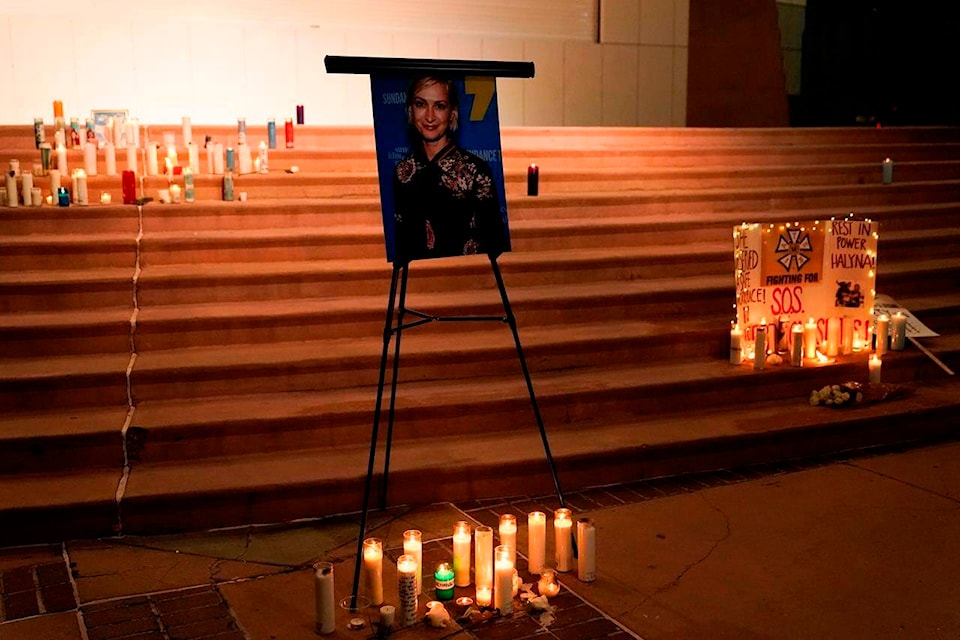ThursdayтАЩs shooting death of cinematographer Halyna Hutchins by a prop revolver during filming for the Alec Baldwin Western тАЬRustтАЭ has the screen industry pondering the future of guns on sets.
Toronto producer Martin Katz of Prospero Pictures says the tragedy near Santa Fe, N.M., raises the question of whether the industry should start using more non-functioning firearms.
Summerland, B.C.-based motion picture and TV property master Dean Goodine predicts the industry will step up gun safety measures, like it did when Brandon Lee was killed by a bullet left in a prop gun on the set of тАЬThe CrowтАЭ in 1993.
Court records say Baldwin pulled the trigger on the revolver that also wounded director Joel Souza during a rehearsal in Santa Fe after an assistant director told him it was тАЬcoldтАЭ тАФ an industry term for a gun that canтАЩt fire.
Experts say theyтАЩre baffled by what Baldwin has called a тАЬtragic accident,тАЭ since sets typically have strict and sufficient protocols in place for handling prop firearms, which should never go off near people or be pointed directly at anyone on set.
Katz wonders if the industry should use more realistic replicas, like 3D-printed models, and avoid showing them in extreme close-ups so audiences canтАЩt tell the difference.
тАЬSo much of what we use in practical effects is not what it appears to be. When we make it snow, itтАЩs not actually snow, itтАЩs soap flakes or some product that was created to look like snow. Why, when we use guns on set, do we actually use real guns?тАЭ says Katz, whose credits include the films тАЬCosmopolisтАЭ and тАЬAkillaтАЩs Escape.тАЭ
тАЬMaybe this is the time towards saying: тАШWe donтАЩt need to shoot movies with actual real guns. We can shoot them with models.тАЩтАЭ
As Goodine describes it, prop guns are often real weapons that could fire a live round but instead are often loaded with тАЬblanksтАЭ тАФ cartridges with gun powder and other material to ignite a flame and sound but no projectile bullet.
On-set guns can also include electric revolvers and CO2-powered versions, similar to pellet guns.
Usually a professional weapons expert called an тАЬarmourerтАЭ will be on set to test and take care of the gun and closely monitor the actor handling it, say experts.
Only the armourer or trained prop master or qualified crew member, along with the actor, are allowed to touch the firearm, says Goodine. The actor isnтАЩt given the firearm until the very last minute before filming, when everyone gets out of the line of fire, and never handles it during rehearsal.
Toronto producer Don Carmody says in most major jurisdictions in Canada, police officers supervise use of blanks or pyrotechnics on set. Camera crews are also often protected by a sheet of Plexiglas if a blank is fired.
тАЬGenerally the safety protocols on a set, certainly anywhere in Canada, are really strenuously observed, right down to the (emergency task force) officers on the stage,тАЭ says Carmody, whose credits include тАЬThe Boondock SaintsтАЭ and тАЬResident EvilтАЭ film franchises.
But problems have happened on home soil.
Carmody says on the set of the 1991 Chuck Norris film тАЬThe HitmanтАЭ he produced in Vancouver, a barrel constrictor came loose on an automatic weapon using blanks and hit a stuntman. The wetsuit he was wearing as a safety measure wasnтАЩt big enough and the barrel constrictor flew into a gap in the clothing, hitting his liver, but he survived.
Goodine says the Lee tragedy saw the industry increase the amount of armourers on sets тАЬtenfold.тАЭ
He predicts the тАЬRustтАЭ killing will see more companies тАЬmove away from firing blanks entirely.тАЭ
тАЬRight now, probably every script in Hollywood is getting a hard look to see what they can write instead of guns,тАЭ says Goodine, whose credits include тАЬLegends of the Fall,тАЭ тАЬPasschendaeleтАЭ and тАЬInception.тАЭ
тАЬIf you have a police show and somebody pulls out their Glock and theyтАЩre going to fire it, theyтАЩre going to CGI the muzzle flash. YouтАЩre going to see a lot more CO2.тАЭ
The тАЬmuzzle flashтАЭ is the light and impact of the gun.
READ MORE:
Experts say in most cases, the muzzle flash and gun smoke could be easily replaced by sound and CGI, which is often preferable to an actual gun going off.
Goodine says in the past five years, gun scenes have been written out of a lot of the family projects heтАЩs worked on.
But heтАЩs also noticed prep periods being condensed and decisions being made at the last-minute, which pose a safety hazard for any gun scenes.
He advises film students not to race to be department heads, so they have the experience and confidence to tell a director not to do something thatтАЩs unsafe.
тАЬThe speed the industry has grown in the last eight years because of new media has put so many people in positions they shouldnтАЩt be in, and IтАЩm not hard on the people that have taken those positions,тАЭ says Goodine.
тАЬI have had so many conversations in the last seven or eight years with people who are in management of these shows that have no clue what we do. It is astonishing to me. I had an accountant tell me on a big show that props is an afterthought in the budget. Well, after (Thursday), itтАЩs not an afterthought anymore.тАЭ
Victoria Ahearn, The Canadian Press
Like us on and follow us on .



